Table of Contents
Introduction
According to Digital Currency Statistics, Digital currency, also known as cryptocurrency, is a type of virtual money based on blockchain technology, offering decentralization, cryptographic security, and various forms like cryptocurrencies (e.g., Bitcoin, Ethereum), central bank digital currencies (CBDCs), stablecoins, and tokenized assets.
Transactions are secured through cryptography, and ownership is verified using private and public keys. Digital currencies have use cases in online transactions, remittances, investments, and cross-border transfers but are characterized by price volatility and face regulatory scrutiny. They rely on consensus mechanisms like mining or proof-of-stake for transaction validation.
Despite challenges, they continue to innovate, attracting investment and reshaping the financial landscape with applications like decentralized finance (DeFi) and non-fungible tokens (NFTs) while undergoing varying degrees of global adoption.
Editor’s Choice
- In 2022, the Digital Currency market revenue stood at USD 25.2 billion and is projected to rise to USD 76.9 billion in 2032, reflecting a positive upward trend.
- Bitcoin maintains its dominant position, contributing substantially to the market’s revenue, followed by Ethereum, Litecoin, Ripple, and other cryptocurrencies.
- As of the end of 2021, it’s estimated that nearly 300 million people worldwide have become cryptocurrency owners, indicating the widespread adoption of digital assets.
- The total market capitalization of stablecoins has taken a notable hit, shrinking by $29.5 billion since January 2022.
- Industry experts are making ambitious predictions, estimating that tokenized digital securities issuing could reach a staggering $4 trillion to $5 trillion by 2030.
- As of August 2023, Ethereum processed over one million daily on-chain transactions, surpassing Bitcoin, which handled 550,000 transactions that month. Other major cryptocurrencies had lower transaction activity.
- Cryptocurrency mining has seen a consistent rise in revenue, reaching a peak of $63 million in a single day in 2021.
Global Digital Currency Market Overview
Global Digital Currency Market Size
- The digital currency market has been experiencing remarkable growth in recent years, with a steady increase in market revenue at a CAGR of 12.13%.
- In 2022, the market revenue stood at USD 25.2 billion, and this figure is projected to rise to USD 28.3 billion in 2023, reflecting a positive upward trend.
- Looking ahead to the year 2030, market revenue is expected to reach USD 60.3 billion, and the growth trend continues through 2031 and 2032, with projected revenues of USD 67.7 billion and USD 76.9 billion, respectively.
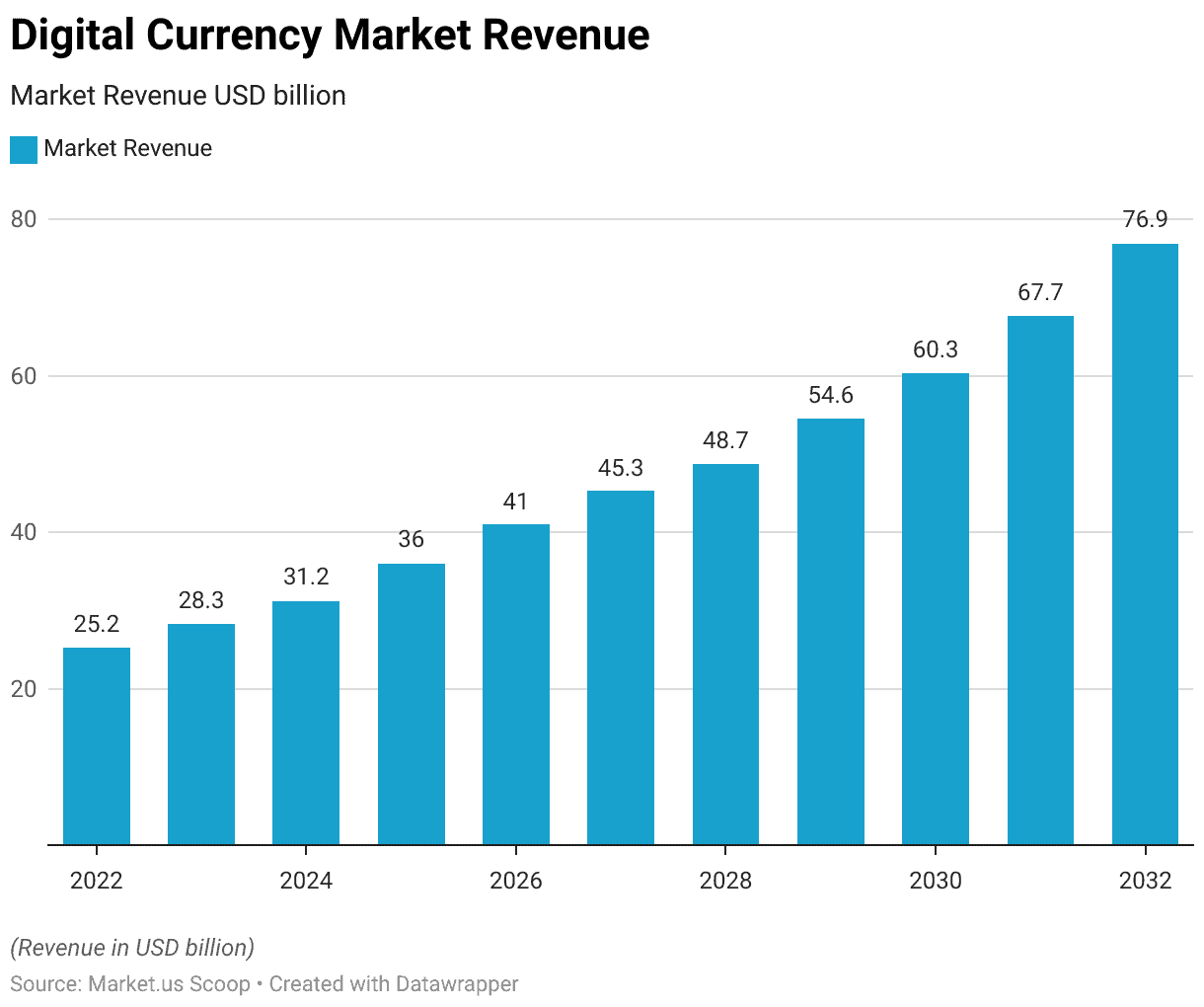
Digital Currency Market Revenue- By Type
- The global digital currency market exhibits a dynamic landscape with revenue streams from various cryptocurrency types.
- In 2022, the total market revenue was recorded at USD 25.2 billion, with Bitcoin contributing USD 10 billion, Ethereum with USD 6 billion, Litecoin with USD 4 billion, Ripple with USD 3 billion, and other cryptocurrencies collectively accounting for an additional USD 3 billion.
- By 2032, the digital currency market is projected to reach a substantial USD 76.9 billion, reflecting the increasing global adoption and diversification of cryptocurrencies within this rapidly evolving financial ecosystem.
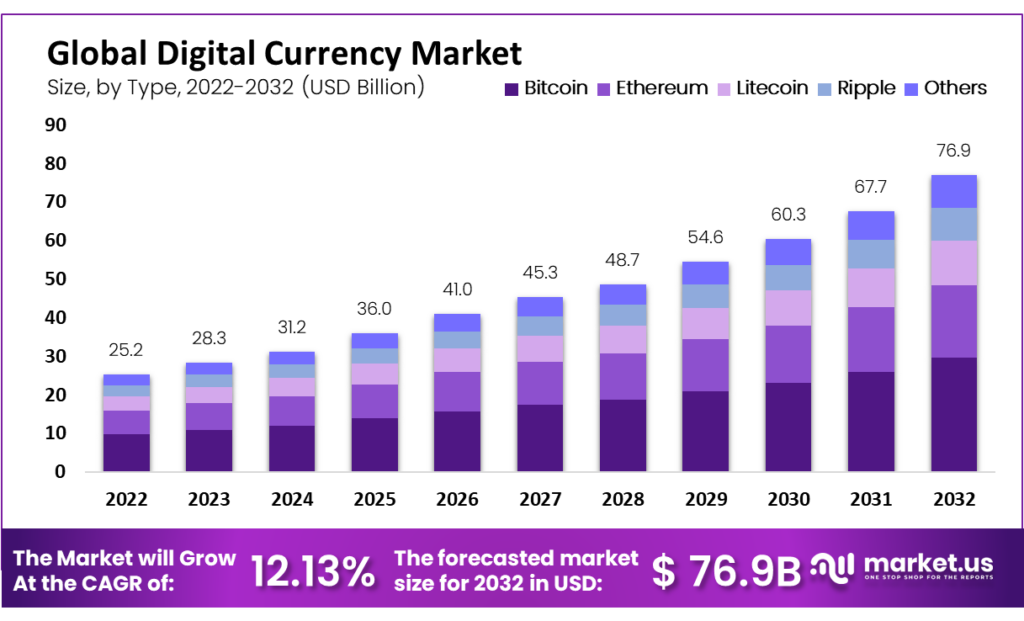
Global Digital Currency Market Share- By End-use Industry
- The global digital currency market is distributed across various end-use industries, each contributing to its unique market share.
- The latest data shows that trading activities hold the largest share, accounting for 32% of the market.
- Retail and e-commerce follow closely, representing 27% of the market share, indicating the growing acceptance of digital currencies in everyday consumer transactions.
- Government entities also play a noteworthy role, with an 11% market share, reflecting their increasing exploration of digital currencies for various applications.
- The banking sector, a pivotal player in the financial landscape, contributes 18% to the market share.
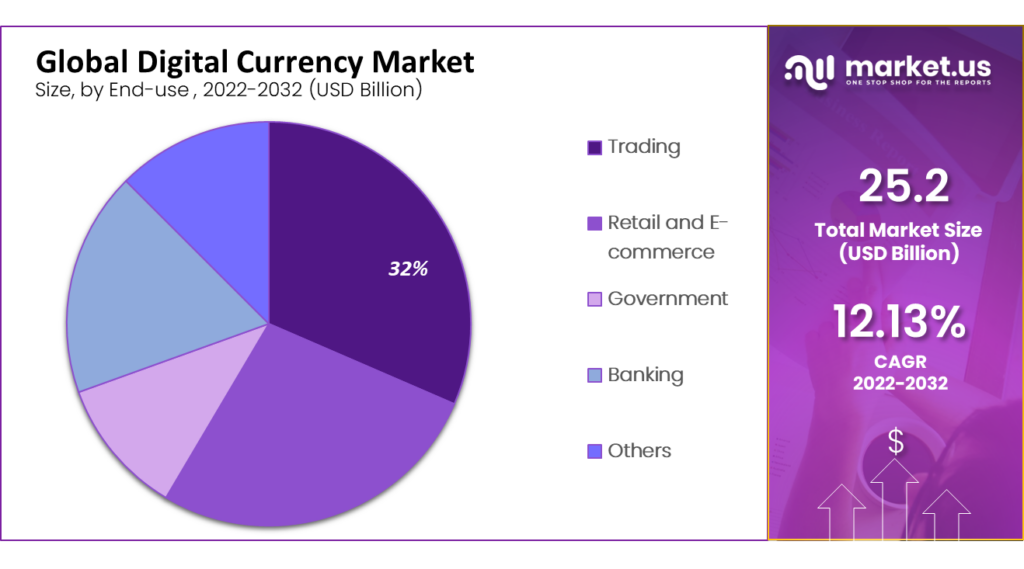
Types of Digital Currencies
Cryptocurrencies
- As of the end of 2021, it’s estimated that nearly 300 million people worldwide have become cryptocurrency owners, indicating the widespread adoption of digital assets.
- The global cryptocurrency market reached a substantial capitalization of £621 billion in 2022.
- Looking ahead to 2030, experts anticipate a significant 12.5% compound annual growth rate for the worldwide cryptocurrency market.
- A survey conducted by Forbes Advisor reveals that 65% of the investing public has invested in cryptocurrencies, highlighting the increasing interest in this asset class.
- When we focus on the UK population specifically, a separate Forbes Advisor survey found that 9% of individuals in the UK currently hold cryptocurrency investments.
- This aligns with research from the Financial Conduct Authority (FCA), which reports that nearly 4.97 million people in the UK, nearly 10% of the population, own some form of cryptocurrency.
- Projections suggest that the UK’s cryptocurrency user base is set to expand significantly, reaching 22.23 million users by 2027.
Central Bank Digital Currencies (CBDCs)
- CBDCs have garnered increased attention due to shifts in payment methods, financial practices, technological advancements, and the disruptions brought about by the COVID-19 pandemic.
- A survey conducted in 2021 by the Bank for International Settlements (BIS) involving central banks discovered that 86% of them are actively engaged in exploring the possibilities of CBDCs.
- Additionally, 60% of these central banks were in the experimental phase with the technology, while 14% had initiated pilot projects to test its implementation.
- In early 2023, a remarkable projection suggests an extraordinary 260,000 percent increase in the value of transactions facilitated by central bank digital currencies (CBDCs) between 2023 and 2030.
- It’s important to acknowledge that information about CBDCs remains somewhat limited at this point, primarily because numerous countries were actively developing their digital currencies in 2023.
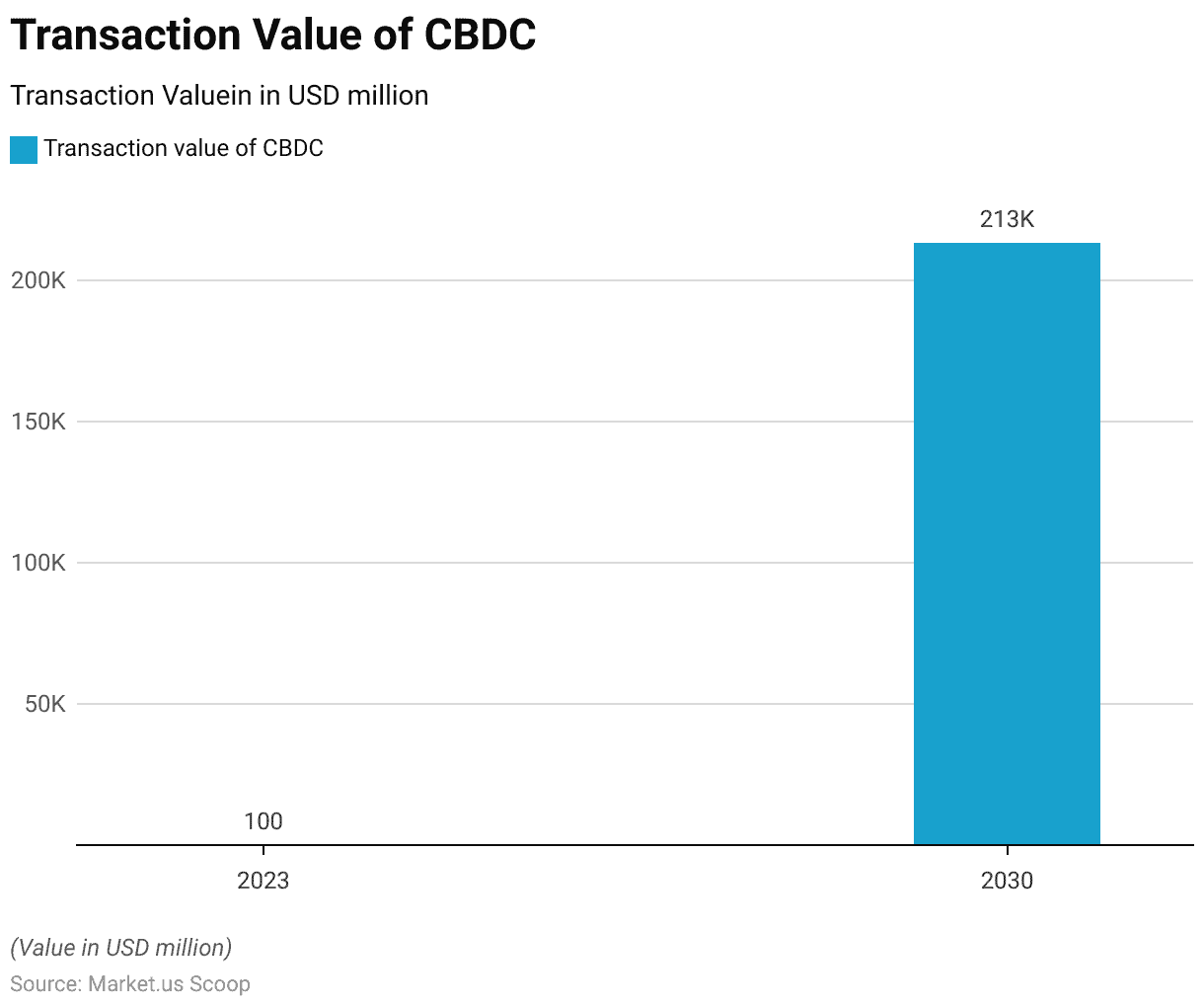
Stablecoins
- The total market capitalization of stablecoins has taken a notable hit, shrinking by $29.5 billion since January 2022.
- In perspective, the stablecoins market began the year with a capitalization of $167.9 billion on January 1, 2022, but by January 31, 2023, it had reduced to $138.4 billion. This contraction represents a significant 17.6% decline in the overall market capitalization of stablecoins.
- In this period, all stablecoins faced a decline in their market capitalization, except for two standout performers, USD Coin (USDC) and Binance USD (BUSD).
- Tether (USDT) experienced a 13.5% drop, Dai (DAI) declined by 42.7%, and Frax (FRAX) decreased by 43.5%. In contrast, USDC and BUSD saw growth in their absolute market capitalization, with USDC expanding by 1.2% and BUSD leading the way with an impressive 8.9% increase.
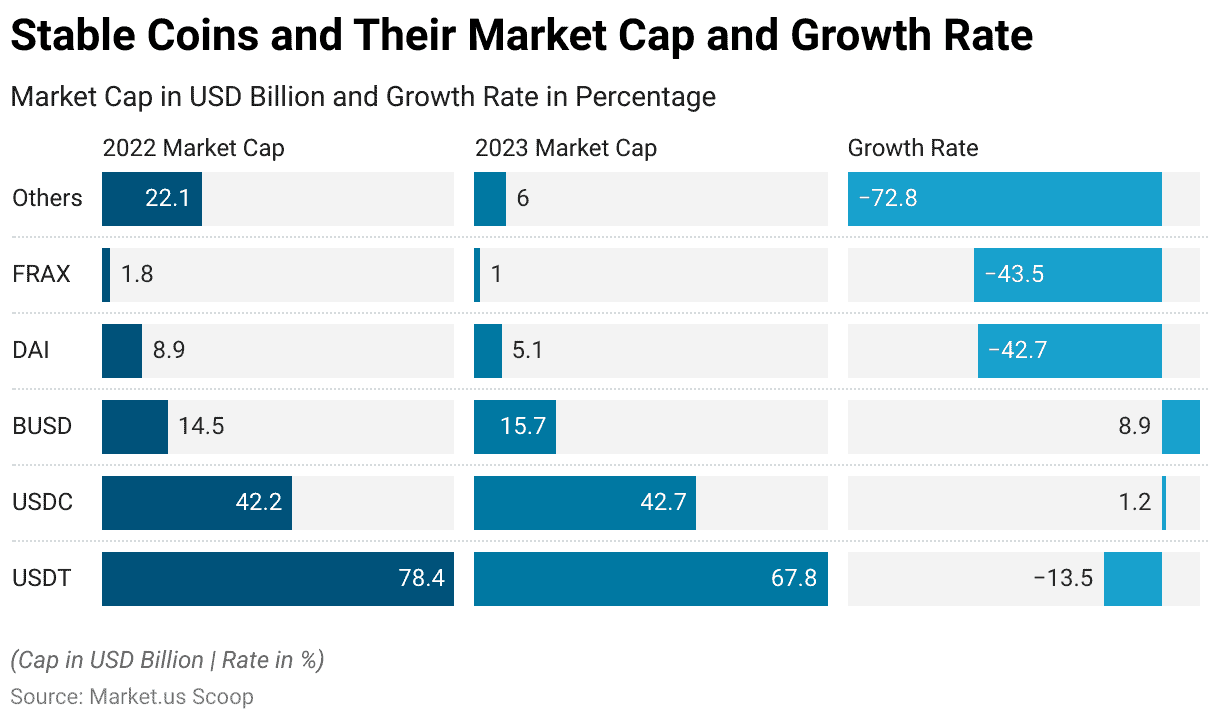
Tokenized Assets
- Industry experts are making ambitious predictions, estimating that tokenized digital securities issuing could reach a staggering $4 trillion to $5 trillion by 2030.
- Although these figures are essentially educated guesses, real-world examples of large-scale implementation are starting to emerge.
- For instance, Broadridge, a fintech infrastructure firm based in the United States, actively facilitates monthly transactions worth over $1 trillion in tokenized repurchase agreements through its Distributed Ledger Repo (DLR) platform.
- This tangible demonstration underscores tokenized digital securities’ growing traction and potential within the financial landscape.
- The market for tokenized assets is poised for substantial growth in the coming years, with projections indicating a remarkable expansion.
- In 2023, the market size is estimated at USD 0.4 trillion, expected to increase to USD 0.6 trillion in 2024.
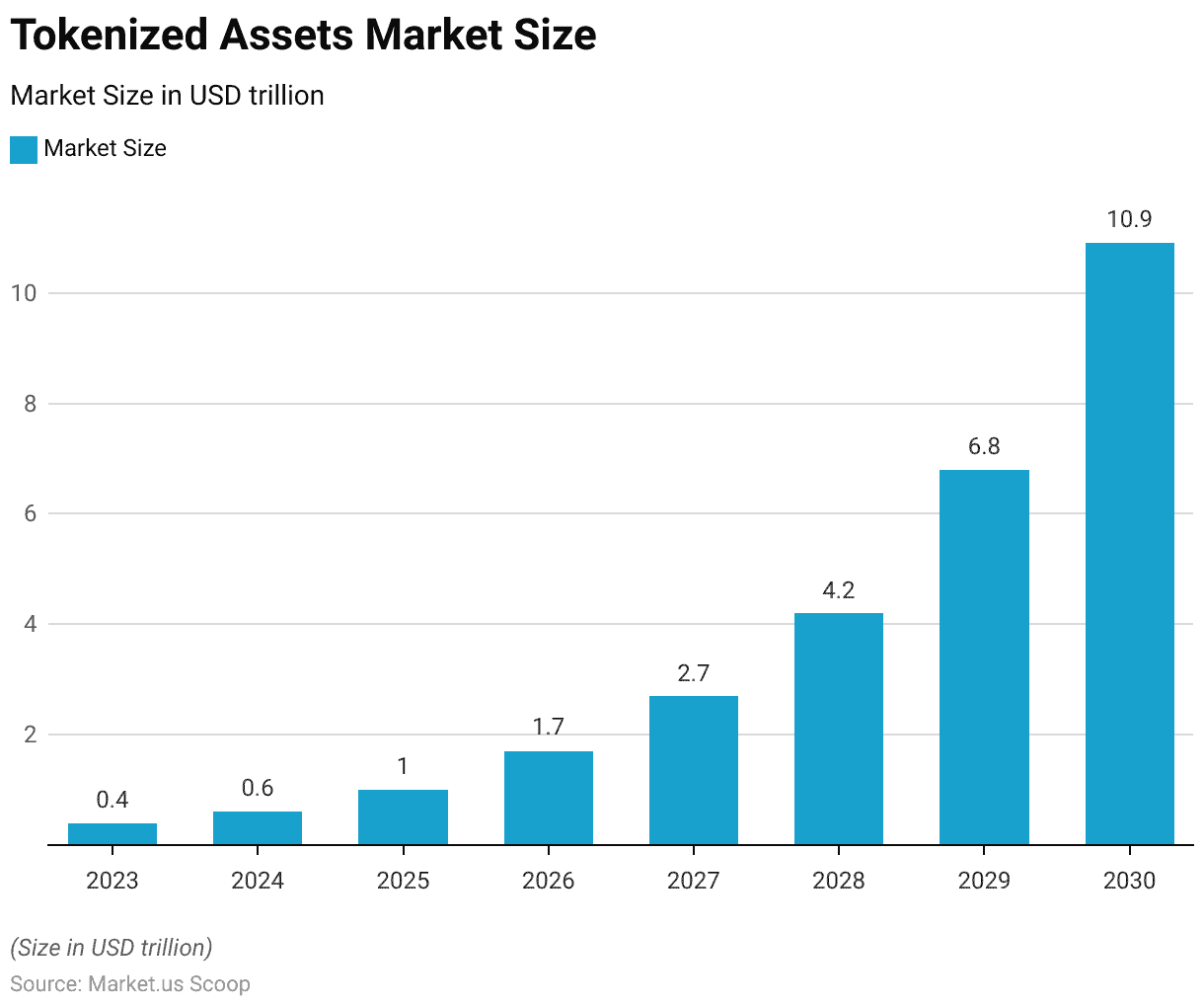
Digital Currency Adoption and Usage
- In 2023, a notable trend emerged as consumers in various African, Asian, and South American countries showed a growing interest in cryptocurrencies, particularly Bitcoin.
- For instance, Nigeria had nearly one in three survey participants reporting cryptocurrency ownership or usage. At the same time, in the United States, this figure was much lower, with only six out of every 100 respondents involved in crypto.
- This shift in ownership patterns contrasted with a ranking of Bitcoin trading volumes across 44 countries, where Russia and the United States led in trading activity.
- Notably, African and Latin American nations also made significant strides.
Transaction Volume of Digital Currencies
- As of August 2023, Ethereum processed over one million daily on-chain transactions, surpassing Bitcoin, which handled 550,000 transactions that month. Other major cryptocurrencies had lower transaction activity.
- The 24-hour trading volume in the crypto market decreased throughout 2023, falling to one-third of its 2022 levels.
- This decline was influenced by legal actions against two major crypto exchanges, Binance, and Coins, in the United States.
- Furthermore, the crypto market became quieter after April, lacking the strong narrative that characterized 2021 and 2022 when cryptocurrencies drew significant attention.
Mining of Digital Currencies
- Cryptocurrency mining has seen a consistent rise in revenue, reaching a peak of $63 million in a single day in 2021.
- Bitcoin mining is an investment strategy that involves calculating energy and hardware costs against the anticipated profits.
- In 2021, most Bitcoin mining activity was traced back to the United States, as indicated by IP addresses associated with miners who participated in specific Bitcoin mining pools.
- This shift can be attributed to global energy pricing disparities, with Germany, for instance, having electricity costs more than ten times higher than countries like China.
Regulatory Aspects of Digital Mining
- The first mention of cryptocurrency in federal law occurred in late 2021 through the Infrastructure Investment and Jobs Act.
- This legislation primarily focused on the tax aspects of cryptocurrency exchanges, although it won’t take effect until 2024.
- However, there’s a growing demand for more comprehensive regulations.
Discuss your needs with our analyst
Please share your requirements with more details so our analyst can check if they can solve your problem(s)



